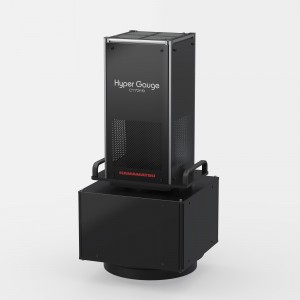
Particle accelerators hold great potential for semiconductor applications, medical imaging and therapy, and research in materials, energy and medicine. But conventional accelerators require plenty of elbow room — kilometers — making them expensive and limiting their presence to a handful of national labs and universities.
Researchers from The University of Texas at Austin, several national laboratories, European universities and the Texas-based company TAU Systems Inc. have demonstrated a compact particle accelerator less than 20 meters long that produces an electron beam with an energy of 10 billion electron volts (10 GeV). There are only two other accelerators currently operating in the U.S. that can reach such high electron energies, but both are approximately 3 kilometers long.
“We can now reach those energies in 10 centimeters,” said Bjorn “Manuel” Hegelich, associate professor of physics at UT and CEO of TAU Systems, referring to the size of the chamber where the beam was produced. He is the senior author on a recent paper describing their achievement in the journal Matter and Radiation at Extremes.
Hegelich and his team are currently exploring the use of their accelerator, called an advanced wakefield laser accelerator, for a variety of purposes. They hope to use it to test how well space-bound electronics can withstand radiation, to image the 3D internal structures of new semiconductor chip designs, and even to develop novel cancer therapies and advanced medical-imaging techniques.
This kind of accelerator could also be used to drive another device called an X-ray free electron laser, which could take slow-motion movies of processes on the atomic or molecular scale. Examples of such processes include drug interactions with cells, changes inside batteries that might cause them to catch fire, chemical reactions inside solar panels, and viral proteins changing shape when infecting cells.

A drawing of the compact wakefield laser accelerator developed at The University of Texas at Austin. A laser beam enters on the right side and travels into the gas cell where an electron beam is created, which travels eventually to two scintillating screens (DRZ1 and DRZ2) for analysis on the left side.
The concept for wakefield laser accelerators was first described in 1979. An extremely powerful laser strikes helium gas, heats it into a plasma and creates waves that kick electrons from the gas out in a high-energy electron beam. During the past couple of decades, various research groups have developed more powerful versions. Hegelich and his team’s key advance relies on nanoparticles. An auxiliary laser strikes a metal plate inside the gas cell, which injects a stream of metal nanoparticles that boost the energy delivered to electrons from the waves.
The laser is like a boat skimming across a lake, leaving behind a wake, and electrons ride this plasma wave like surfers.
“It’s hard to get into a big wave without getting overpowered, so wake surfers get dragged in by Jet Skis,” Hegelich said. “In our accelerator, the equivalent of Jet Skis are nanoparticles that release electrons at just the right point and just the right time, so they are all sitting there in the wave. We get a lot more electrons into the wave when and where we want them to be, rather than statistically distributed over the whole interaction, and that’s our secret sauce.”
For this experiment, the researchers used one of the world’s most powerful pulsed lasers, the Texas Petawatt Laser, which is housed at UT and fires one ultra-intense pulse of light every hour. A single petawatt laser pulse contains about 1,000 times the installed electrical power in the U.S. but lasts only 150 femtoseconds, less than a billionth as long as a lightning discharge. The team’s long-term goal is to drive their system with a laser they’re currently developing that fits on a tabletop and can fire repeatedly at thousands of times per second, making the whole accelerator far more compact and usable in much wider settings than conventional accelerators.

A gas cell drawing. Inside, an extremely powerful laser strikes helium gas, heats it into a plasma and creates waves that kick out electrons from the gas in a high-energy electron beam. Nanoparticles, generated by a secondary laser shining through the top window and striking a metal plate, boost the energy transferred to the electrons.
The study’s co-first authors are Constantin Aniculaesei, corresponding author now at Heinrich Heine University Düsseldorf, Germany; and Thanh Ha, doctoral student at UT and researcher at TAU Systems. Other UT faculty members are professors Todd Ditmire and Michael Downer.
Hegelich and Aniculaesei have submitted a patent application describing the device and method to generate nanoparticles in a gas cell. TAU Systems, spun out of Hegelich’s lab, holds an exclusive license from the University for this foundational patent. As part of the agreement, UT has been issued shares in TAU Systems.
Support for this research was provided by the U.S. Air Force Office of Scientific Research, the U.S. Department of Energy, the U.K. Engineering and Physical Sciences Research Council and the European Union’s Horizon 2020 research and innovation program.































 Back to News
Back to News



























